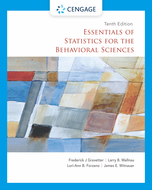Solution Found!
?Everyone experiences “ups and downs” in life satisfaction. Boehm, Winning, Segerstrom
Chapter 4, Problem 34(choose chapter or problem)
Everyone experiences “ups and downs” in life satisfaction. Boehm, Winning, Segerstrom, and Kubzansky (2015) studied whether such variability in life satisfaction is correlated with mortality rate. Over a nine-year period, 4,458 Australian older adult participants answered surveys about life satisfaction, and the researchers recorded whether the participants were deceased at the time of planned follow-up interviews. Participants rated their life satisfaction on a scale of 0 (dissatisfied) to 10 (satisfied). The researchers observed data similar to the following:
\(\begin{array}{cc} \hline \text { Low Mortality Sample } & \text { High Mortality Sample } \\ \hline 1 & 0 \\ 6 & 10 \\ 6 & 10 \\ 7 & 4 \\ 6 & 9 \\ 5 & 3 \\ 5 & 0 \\ 3 & 10 \\ 8 & 2 \\ 3 & 3 \\ 5 & 4 \\ \hline \end{array}\)
a. Compute \(M, S S, s^{2}\) , and s for these samples.
b. Report the mean and standard deviation in a format that is appropriate for a scientific journal.
Questions & Answers
QUESTION:
Everyone experiences “ups and downs” in life satisfaction. Boehm, Winning, Segerstrom, and Kubzansky (2015) studied whether such variability in life satisfaction is correlated with mortality rate. Over a nine-year period, 4,458 Australian older adult participants answered surveys about life satisfaction, and the researchers recorded whether the participants were deceased at the time of planned follow-up interviews. Participants rated their life satisfaction on a scale of 0 (dissatisfied) to 10 (satisfied). The researchers observed data similar to the following:
\(\begin{array}{cc} \hline \text { Low Mortality Sample } & \text { High Mortality Sample } \\ \hline 1 & 0 \\ 6 & 10 \\ 6 & 10 \\ 7 & 4 \\ 6 & 9 \\ 5 & 3 \\ 5 & 0 \\ 3 & 10 \\ 8 & 2 \\ 3 & 3 \\ 5 & 4 \\ \hline \end{array}\)
a. Compute \(M, S S, s^{2}\) , and s for these samples.
b. Report the mean and standard deviation in a format that is appropriate for a scientific journal.
ANSWER:Step 1 of 3
a.) Low mortality:
The average value of a group of numbers is shown by the central tendency measure known as the mean, M. Summarizing all of the values and dividing by the total number of values yields the mean of a collection of numbers. Because it is straightforward to compute, clear to grasp, and helpful for comparing various data sets, the mean is frequently employed as a benchmark for measuring central tendency. The formula for calculating M for a given sample is:
\(M=\frac{\sum x}{n}\)
Here, X is the sum of all the scores, and n is the sample size.
Substitute the values in the above formula, and we get,
\(\begin{array}{l} M=\frac{1+6+6+7+6+5+5+3+8+3+5}{11} \\ M=\frac{55}{11} \\ M=5 \end{array}\)
